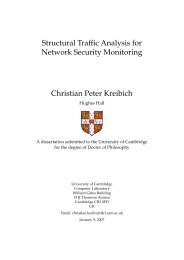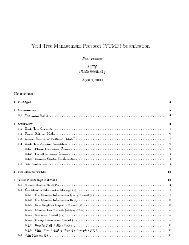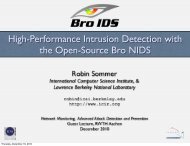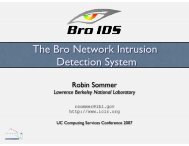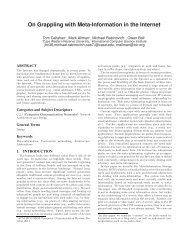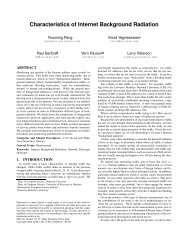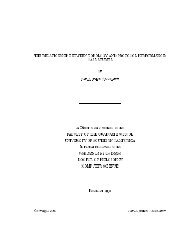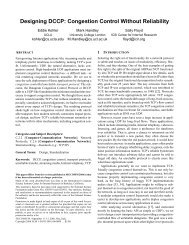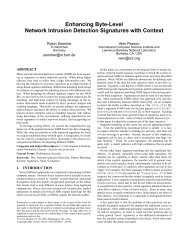SIFF: A Stateless Internet Flow Filter to Mitigate DDoS Flooding Attacks
SIFF: A Stateless Internet Flow Filter to Mitigate DDoS Flooding Attacks
SIFF: A Stateless Internet Flow Filter to Mitigate DDoS Flooding Attacks
You also want an ePaper? Increase the reach of your titles
YUMPU automatically turns print PDFs into web optimized ePapers that Google loves.
<strong>to</strong> any destination address (even if the destination does not<br />
want <strong>to</strong> receive the packet), and the destination has no<br />
way of s<strong>to</strong>pping those packets before they reach it (or its<br />
network). Although many innovative avenues of defense<br />
against DoS and <strong>DDoS</strong> have been explored in the literature<br />
(we review some of these in the next section), only a few<br />
of the approaches even address the <strong>DDoS</strong> flooding problem.<br />
In this paper, we explore the design issues involved<br />
in constructing a system from scratch that solves the <strong>DDoS</strong><br />
flooding problem by giving a packet receiver control over<br />
which packets the network delivers <strong>to</strong> it.<br />
1.1 Related Work<br />
Several researchers have studied the frequency and nature<br />
of <strong>Internet</strong> DoS attacks [16, 17, 21, 24, 31]. In this<br />
section, we review related work in the area of <strong>Internet</strong> DoS<br />
defenses. We distinguish the research in<strong>to</strong> two general areas:<br />
defending against IP source address spoofing, and defending<br />
against bandwidth flooding attacks.<br />
We first discuss research in defenses against source IP<br />
address spoofing. Ferguson and Senie propose <strong>to</strong> deploy<br />
network ingress filtering <strong>to</strong> limit spoofing of the source IP<br />
address [15]. Burch and Cheswick propose <strong>to</strong> use a limited<br />
form of DoS attack <strong>to</strong> probe which links are affected<br />
by an attack and can thus trace back <strong>to</strong> the origin [8]. Park<br />
and Lee propose a distributed packet filtering (DPF) mechanism<br />
against IP address spoofing [32]. DPF relies on BGP<br />
routing information <strong>to</strong> detect spoofed IP addresses.<br />
Bellovin et al. suggests adding a new type of ICMP message<br />
for traceback [6], and Mankin et al. present an improvement<br />
<strong>to</strong> this scheme [28]. Several researchers propose<br />
<strong>to</strong> embed traceback information within the IP packet [2, 12,<br />
19, 26, 35, 38, 43]. Most of these schemes use the 16-bit IP<br />
Identification field <strong>to</strong> hold traceback information. Routers<br />
along the packet’s path probabilistically mark bits in the<br />
IP Identification field in different ways. While traceback<br />
schemes could be used <strong>to</strong> find the origins of the attacks,<br />
they often require a large number of packets and cannot be<br />
used <strong>to</strong> filter out packets on a per-packet basis.<br />
Snoeren et al. propose a mechanism using router state <strong>to</strong><br />
track the path of a single packet [37]. Their approach enables<br />
a victim <strong>to</strong> trace back a single packet by querying the<br />
router state of upstream routers. In earlier work, we propose<br />
the Pi marking scheme <strong>to</strong> enable the victim <strong>to</strong> detect<br />
packets with a spoofed source IP address [47]. Pi is not effective<br />
against bandwidth flooding attacks because it relies<br />
on victim filtering of <strong>DDoS</strong> traffic and bandwidth flooding<br />
typically causes damage (i.e., dropped packets) upstream<br />
from the victim.<br />
The IP traceback and spoofing defenses we discussed<br />
so far, defend against <strong>DDoS</strong> at the victim of the attack.<br />
The research most closely related with our work attempts<br />
<strong>to</strong> defend against network flooding attacks in the network<br />
itself. S<strong>to</strong>ne proposes the CenterTrack mechanism, which<br />
uses routers capable of input debugging (the ability <strong>to</strong> determine<br />
through which router interface a particular packet<br />
was received) that would be virtually connected through IP<br />
tunnels <strong>to</strong> all border routers on a network [42]. When a node<br />
in the network comes under attack, the overlay network is<br />
activated, and all border routers channel traffic through the<br />
overlay routers. These routers would use input debugging <strong>to</strong><br />
determine from which border router, and hence from which<br />
neighbor network, the <strong>DDoS</strong> traffic is coming from. However,<br />
this technique requires that the ISP create the overlay<br />
network and perform filtering, and may not be practical for<br />
large attacks.<br />
Generalized network congestion control is related <strong>to</strong><br />
<strong>DDoS</strong> defense. Ioannidis et al. propose Aggregate Congestion<br />
Control (ACC)/Pushback, which leverages router support<br />
<strong>to</strong> rate-limit groups of similar packets responsible for<br />
congestion, and push filters upstream <strong>to</strong>wards the sources<br />
of those packets <strong>to</strong> preserve network bandwidth [22, 27].<br />
ACC/Pushback requires non-negligible state at routers and<br />
faces challenges in attack traffic identification and ISP interoperation.<br />
S<strong>to</strong>ica et al. propose a mechanism for <strong>Stateless</strong><br />
Fair Queueing (SFQ) in the network core [40]. Their<br />
scheme has edge routers maintain per-flow arrival-rate information.<br />
Edge routers label packets based on their flow’s<br />
rate information, and core network routers use probabilistic<br />
dropping based on the packet labels <strong>to</strong> fairly distribute<br />
bandwidth among flows. SFQ requires that the malicious<br />
flows’ edge routers implement the labeling, so that those<br />
flows can be rate limited in the core.<br />
Researchers recently investigated using overlay networks<br />
<strong>to</strong> mitigate the effect of DoS attacks. Keromytis et<br />
al. designed the Secure Overlay Services (SOS) architecture<br />
<strong>to</strong> proactively defend against DoS attacks [25]. SOS<br />
uses an overlay network <strong>to</strong> authenticate users and installs<br />
filters at the ISP level. Anderson generalizes the SOS architecture<br />
by considering different filtering techniques and<br />
overlay routing mechanisms and proposes Mayday [4]. Adkins<br />
et al. propose the use of the <strong>Internet</strong> Indirection Infrastructure<br />
(i3) [39] <strong>to</strong> enable the victim <strong>to</strong> s<strong>to</strong>p individual<br />
flows by removing the unique forwarding pointer that each<br />
sender possesses [1]. An advantage of these techniques is<br />
that they do not require changing the current <strong>Internet</strong> infrastructure.<br />
However, they assume presence of an overlay<br />
infrastructure, they require per-flow state in the overlay network,<br />
and they assume updated client and server software<br />
and pro<strong>to</strong>cols.<br />
Mirkovic et al. propose D-Ward, an au<strong>to</strong>mated system<br />
that detects flooding attacks on a link and au<strong>to</strong>matically installs<br />
filters [29]. In their system, the receiver has no control<br />
over these filters, and so the receiver has no way of s<strong>to</strong>pping<br />
a widely distributed flooding attack or choosing flows<br />
2





